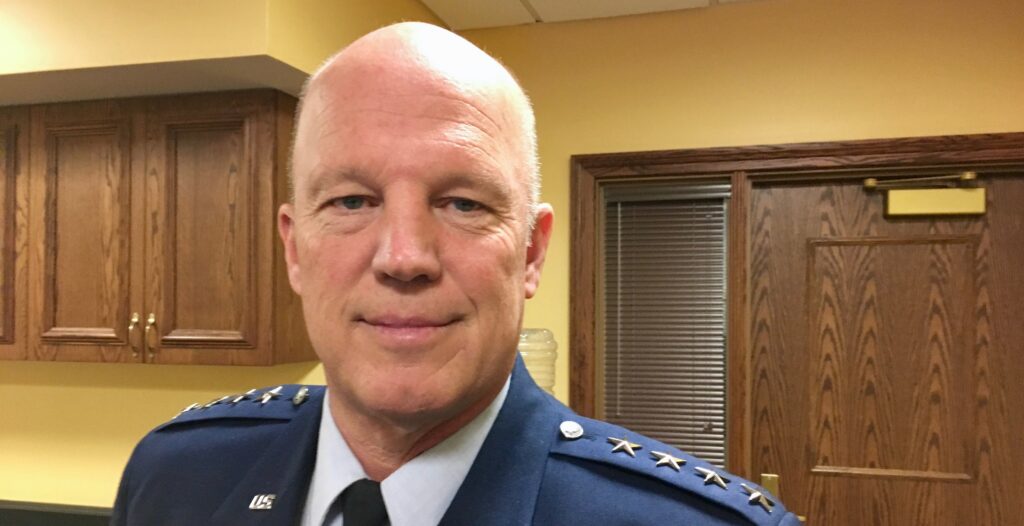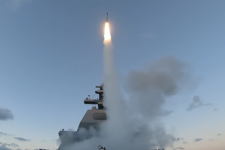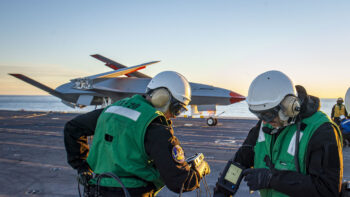
Gen. Jay Raymond, Commander, Space Command
WASHINGTON: The new Space Force will be led by a Chief of Space Operations (CSO) who will serve under the Air Force and sit on the Joint Chiefs of Staff, mandates the new NDAA approved late last night.
The Marine Corps-like structure follows the language put forward by the House in its version of the NDAA.
“The legislation has all the things you need for an independent military service: its own budget authority, its own personnel system, its own acquisition authority, and a seat on the Joint Chiefs,” says Todd Harrison, a space expert at the Center for Strategic and International Studies.
However, reflecting the deep concern in the Senate and among many House Democrats about the costs and concept of the Space Force, the bill also includes a number of provisions designed to allow Congress to keep a tight hold on the formation of the new service and its budget.
First of all, the Space Force CSO — who for the first year can be double-hatted by the head of US Space Command Gen. Jay Raymond — is required to report to Congress every 60 days about implementation until 2023. As Breaking D readers know, the Pentagon had recommended that Raymond, who currently also serves as head of Air Force Space Command, also take over the helm of the Space Force — at least through the initial transition period.
Second, the new Space Force will be made up only of Air Force personnel who are transferred; no new billets are authorized in order to: “minimize cost and bureaucracy.”
“I think the success of the Space Force will now depend on how effective Secretary of Defense Mark Esper is at making sure the other services transfer all of their space organizations and personnel to the Space Force in the coming years,” Harrison told Breaking D. “The last thing we want is to end up with four Space Forces, like how we ended up with four Air Forces after the National Security Act of 1947.”
Bottom line: the Space Force will in essence be a renamed Air Force Space Command (AFSPC) unless and until Congress moves to allow personnel from the other services to be re-assigned. Indeed, the bill limits spending on the Space Force in 2020 to the $72.4 million requested by the Pentagon for the standup.
Third, the NDAA takes language from the Senate version to create a new assistant secretary of the Air Force for space acquisition and integration, who will “serve as the space architect” and senior space acquisition executive in the Pentagon. The space architect takes over all space programs now managed by Air Force acquisition czar Will Roper in 2022. The office also will oversee the Space Rapid Capabilities Office, the (Air Force’s) Space and Missile Systems Center and the the Space Development Agency.
The bill language charges the office to:
- Provide a renewed focus on the acquisition of space systems as the chair of the Space Force Acquisition Council, ensuring integration across the national security space enterprise;
- Synchronize with the Air Force Service Acquisition Executive on all space system efforts, and take on those responsibilities for space systems and programs effective on Oct. 1, 2022; and
- Oversee and direct the Space and Missile Systems Center, Space Rapid Capabilities Office, and Space Development Agency.
The assistant secretary further will chair a newly developed Space Force Acquisition Council that will report directly to the Air Force Secretary. The council also will include the Air Force undersecretary, a newly created assistant secretary of Defense for Space Policy, the director of the National Reconnaissance Office, the Space Force CSO and the head of Space Command.
According to the conference report, “The Council shall oversee, direct, and manage acquisition and integration of the Air Force for space systems and programs in order to ensure integration across the national security space enterprise.” It further must report to Congress every year through 2025.
The new assistant secretary for Space Policy is mandated as the senior civilian in charge of “space warfighting.” Currently, the senior civilian space policy post is held by Deputy Assistant Secretary of Defense for Space Policy Steve Kitay. That new office also is instructed to immediately contract a federally funded research and development center (FFRDC) to recommend whether the office should fold in “elements on space currently assigned to the office of the undersecretary of Defense for Intelligence or the Military Intelligence Program.
“The more interesting but less important question,” joked Harrison, is “does the fact that Congress named the head of the Space Force the Chief of Space Operations (like the Chief of Naval Operations) mean that Congress is implicitly endorsing a naval rank structure for the Space Force?”
And then, of course, comes the question of new uniforms.
Lockheed wins competition to build next-gen interceptor
The Missile Defense Agency recently accelerated plans to pick a winning vendor, a decision previously planned for next year.


























